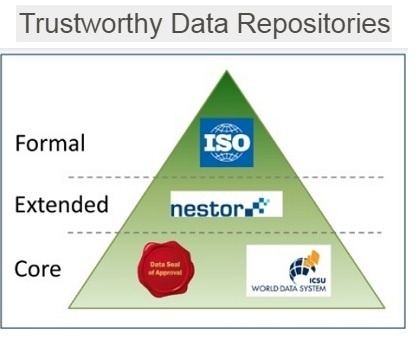Towards Trusted Digital Repositories : accessing, sharing and using quality data


(SlideShare: FAIR Data in Trustworthy Data Repositories)
Accessing, using, sharing and reusing of digital information resources (including data) will always pose challenges. What would you do if the repositories to which you entrust your 'digital capital' let you down? The sustainable management of digital information resources requires support working on well-defined policies and data management plans that include all processes within their specific lifecycle, as well as on standards for Trusted Digital Repositories. This essay presents some information about audit and certification of Trusted Digital Repositories.
_________________________________________________________________________________________________
There is a plethora of models, standards and best practices addressing the different facets for the long-term access of digital information resources (including data). Preservation of these latter in the long term is not limited to storage and backup; rather it involves multifaceted strategies aimed at providing a Trusted environment (covering authenticity, integrity, access, quality, confidentiality issues; see e.g., ICPSR: Data Management & Curation) where information resources can evolve along with the changes in technology, hardware and software.
These multifaceted strategies anticipate and serve the needs of sharing, publication, preservation and long-term access of digital information resources ensuring that they are usable for the benefit of others both at the time of deposit and in the future.
COAR - Next Generation Repositories Working Group, for example, aims to position repositories as the foundation for a distributed, globally networked infrastructure supporting repository functionalities related to discovery, and ensuring the full lifecycle of research processes, the quality assessment of content, TRUST and reliable, community accepted measures. |
More and more communities of practice are starting to build sustainable digital repositories allowing long-term access to data sets and their sharing in a trustworthy and fair digital environments. See, for example:
- ICSU-WDS : Trusted Data Services for Global Science,
- EUDAT,
- DIGITAL SCIENCE : smart support at every stage of the research cycle,
- Dataverse,
- Big Data Europe (BDE),
- European Open Science Cloud,
- agINFRA,
- Zenodo,
- DANS (DANS EASY portal is assessed by NESTOR Seal and the DSA).
The European Framework for Audit and Certification ensures that digital repositories can be granted of different certificates allowing repositories to show one of three symbols (to be agreed upon Basic Certification, Extended Certification, Formal Certification) on their web pages and other documentation, in addition to any other Data Seal of Approval (DSA) , German DIN 31644-standard (and based on it NESTOR seal), or ISO 16363 certification marks.
| On top of the core/basic certification provided by the Data Seal of Approval (DSA: 16 guidelines related to Trustworthy data management and stewardship) and ISCU World Data System (WDS). The NESTOR seal (34 requirements) grants an extended certification. While the NESTOR seal can be obtained as a standalone solution, it also fits into the European Framework for Audit and Certification. On the top of the NESTOR there is a formal audit and certification provided by ISO (based upon the Trusted Digital Repositories and Audit Checklist TRAC). |
The first (Basic Certification) level requires a few days’ effort from the repositories. The DSA and WDS are lightweight tools (you need not to comply with all their requirements) that can be easily used for self-assessment by the community.
The last two (Extended and Formal Certification) levels present auditing standards for digital trusted repositories (TDR) and require several person months to collect much more detailed information than the DSA, to take part in the audits for assessing the trust of digital repositories, considering also that it is ‘not a one-time accomplishment that you achieve and then forget. This requires compliance with numerous regulatory and legal requirements as well as periodic re-assessment audits to confirm that the organization/service remains in compliance with all requirements of the standard.
Digital repositories that have achieved their status as TDR via these standards, have an explicit mission to preserve digital information resources (including data) for the long-term. It is also about ensuring that these resources are usable and reusable for the benefit of others, both at the time of deposit and in the future.
_________________________________________________________________________________________________
You might be also interested in:
- UK-Data_Archive. How to curate data: Standards of Trust
- 2017 NAGARA Conference Session on Trusted Digital Repositories that will be held on 12–15 July 2017 in Boise, Idaho
- ICPSR : Trusted Digital Repositories (Data Management & Curation)
- Open Repositories Conference that will be held on 26-30 June 2017 at the Hilton Brisbane
- Developing Criteria to Establish Trusted Digital Repositories
- A Primer on the Certifications of a Trusted Digital Repository (TDR)
- Edinburgh DataShare that has achieved the ‘Data Seal of Approval’ (DSA)
- PTAB (Primary Trustworthy Digital Repository Authorisation Body) first in the world to be accredited to perform iso 16363 audit and certification
- Trustworthy Repositories (DCC)
- FAIR Principles and Data Management Planning (Webinar@AIMS)
- Put FAIR principles into practice and enjoy your data!
- Certification and Assessment of Digital Repositories
- Data Archives and Digital Preservation (CESSDA)
- Preserving digital heritage: At the crossroads of Trust and Linked Open Data


